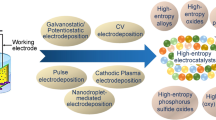Abstract
Reaction mechanism of gold dissolving in alkaline thiourea solution was studied by electrochemical methods, such as cyclic voltammetry, chronopotentiometry, AC impedance, linear sweep voltammetry. Apparent activation energy of anodic process of gold electrode dissolving in alkaline thiourea solution is 14.91 kJ/mol. Rate determining step is the process of gold thiourea complex diffusing away from electrode surface to solution. The results of AC impedance and chronopotentiometry indicate that thiourea adsorbs on gold electrode surface before dissolving in solution. There does not exist proceeding chemical reactions. Formamidine disulfide, the decomposed product of thiourea, does not participate the process of gold dissolution and thiourea complex. Species with electro-activity produced in the process of electrode reaction adsorbs on the electrode surface. In alkaline thiourea solution, gold dissolving mechanism undergoes the following courses: adsorption of thiourea on electrode surface; charge transfer from gold atom to thiourea molecule; Au[SC(NH2)2]ads + receiving a thiourea molecule and forming stable Au[SC(NH2)2]2 +; and then Au[SC(NH2)2]2 + diffusing away from the electrode surface to solution, the last step is the rate-determining one.
Similar content being viewed by others
References
GRONEWALD T. Potential application of thiourea in the processing of gold[J]. J S African Inst M&M, 1977, 77(11): 217–223.
ORGUL S, ALTALAY U. Reaction chemistry of gold leaching in thiourea solution for a Turkish gold ore[J]. Hydrometallurgy, 2002, 67(1/3): 71–77.
DENG T L, LIAO M X, WANG M H, et al. Enhancement of gold extraction from biooxidation residues using an acidic sodium sulphite-thiourea system[J]. Mineral Engineering, 2001, 14(2): 263–268.
KUMAR V, MURTHY D S R, RAO K V. Extraction of gold from an Indian low-grade refractory gold ore through physical beneficiation and thiorea leaching[J]. Hydrometallurgy, 2003, 68(1/3): 125–130.
GONEN N. Leaching of finely disseminated gold ore with cyanide and thiourea solutions[J]. Hydrometallurgy, 2003, 69(1/3) 169–176.
SENANAYAKE G. Gold leaching in non-cyanide lixiviant systems: Critical issues on fundamentals and applications[J]. Minerals Engineering, 2004, 17(6): 785–801.
SENANAYAKE G.. Analysis of reaction kinetics, speciation and mechanism of gold leaching and thiosulfate oxidation by ammoniacal copper(II) solutions[J]. Hydrometallurgy, 2004, 75(1/4): 55–75.
UBALDINI S, FORNARI P, Massidda R, et al. Innovative thiourea gold leaching process[J]. Hydrometallurgy, 1998, 48(1): 113–124.
NINAE M, OBOSO A. TAKENAKA Y, et al. Synergistic extraction of gold from sulfuric acid solution containing thiourea[J]. Nippon Kinzoku Gakkaishi/Journal of the Japan Institute of Metals, 1991, 55(8): 867–873.
GASPAR V, MEJEROVICH A S, MERETUKOV M A. et al. Practical application of potential-pH diagrams for Au-CS(NH2)2-H2O and Ag-SC(NH2)2-H2O systems for leaching gold and silver with acidic thiourea solution[J]. Hydrometallurgy, 1994, 34(3): 369–381.
CHANDRA I, JEFFREY M I. An electrochemical study of the effect of additives and electrolyte on the dissolution of gold in thiosulfate solutions[J]. Hydrometallurgy, 2004, 73(3/4): 305–312.
HUANG Zi-qing. Theory Introduction to Electrolyte Solutions[M]. Beijing: Science Press, 1983: 84–86. (in Chinese)
BARD A J, PARSONS R, JORDAN J. Standard Potentials in Aqueous Solution[M]. International Union of Pure and Applied Chemistry. New York: Basel Press, 1985: 287–321.
HU Yu-de, CHEN Bai-zhen. Investigating Methods of Metallurgical Electrochemistry[M]. Changsha: Central South University of Technology Press, 1990. (in Chinese)
CAO Chu-nan. Electrochemical Principles of Corrosion[M]. Beijing: Chemical Industry Press, 1985: 252–261. (in Chinese)
BARDER A J, FUKNA L R. Principle and Application of Electrochemistry Technique[M]. GU Lin-ying, LÜ Ming-xiang, SONG Shi-zhe, et al translate. Beijing: Chemical Industry Press, 1986: 615. (in Chinese)
Author information
Authors and Affiliations
Corresponding author
Additional information
Foundation item: Project(50004009) supported by the National Natural Science Foundation of China
Rights and permissions
About this article
Cite this article
Chai, Ly., Wang, Yy. Mechanism of gold dissolving in alkaline thiourea solution. J Cent. South Univ. Technol. 14, 485–489 (2007). https://doi.org/10.1007/s11771-007-0094-0
Received:
Accepted:
Published:
Issue Date:
DOI: https://doi.org/10.1007/s11771-007-0094-0




